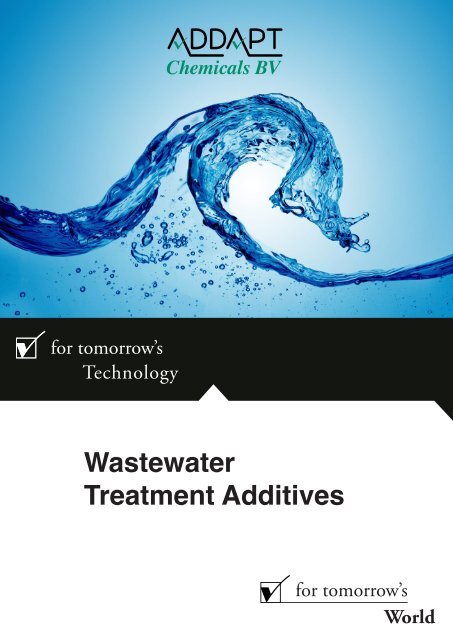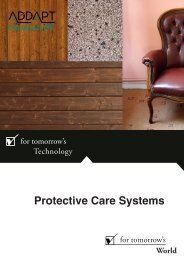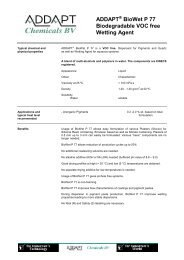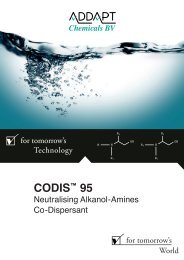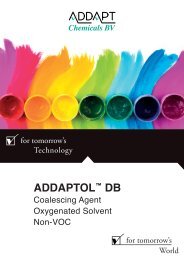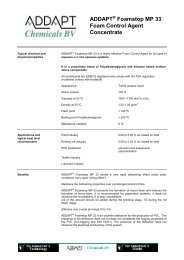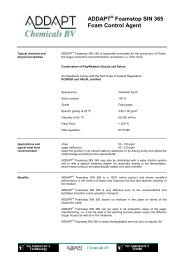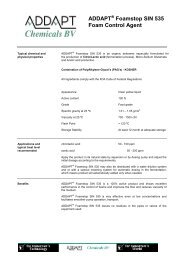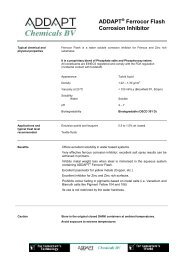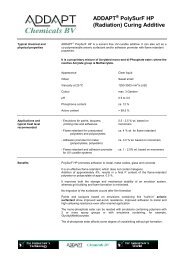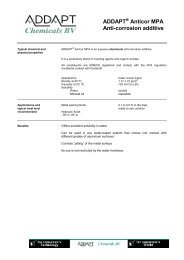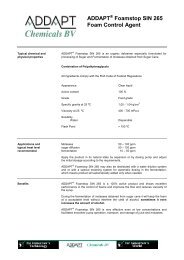'Wastewater Treatment Additives' brochure - ADD APT Chemicals
'Wastewater Treatment Additives' brochure - ADD APT Chemicals
'Wastewater Treatment Additives' brochure - ADD APT Chemicals
- No tags were found...
You also want an ePaper? Increase the reach of your titles
YUMPU automatically turns print PDFs into web optimized ePapers that Google loves.
1. IntroductionIncreasing living standard and consumption of goods is followed by the increase of waste products. Thisimplies that water supply and wastewater treatment obtain high priority for all kind of industries. In order tokeep up with fresh water supply, usage of wastewater treatment plants became a standard practise for themajority of the industries producing considerable amount of wastewater.During purification of the wastewater, there is an increasing tendency of foam-build up. Usage of FoamControl Agents is highly recommended in order to achieve an optimised wastewater treatment process. Theincreasing number of waste treatment plants and the very strict environmental restrictions for industrial wasteleads to a strong increase in Foam Control Agents (FCA).The composition of wastewater varies dramatic and it is advised to split the wastewater in industrialapplications. Industrial wastewater again, differs strongly from communal wastewater. Communal wastewaterconsists mainly of non-ionic and anionic surfactants. Because of the high diluting factor, the communalwastewater does show a high foam tendency. This in contrast to the industrial wastewater, which shows ahigh concentration of industrial waste, dissolved in the water.The increase in foam tendency of industrial wastewater can be found in: Larger wastewater quantities Higher content of foaming substances in the wastewater Biodegradation becomes more difficult; therefore more intensive treatment is required.The chemical industry consumes the highest amount of water (one third of the fresh water consumption).About 80% of this fresh water is used for cooling processes. The chemical process takes 16% of the usedwater in account and only 2% is used as boiling feed water and drinking water for employees.Chemical industries that produce and/or handle emulsions based systems and industries handling methylcellulose do produce wastewater with a strong foam tendency.Running a wastewater treatment plant is not an easy task because of the different kind of chemicalsdissolved in the wastewater. Adequate inoculums have to be selected enabling one to biodegrade thechemicals dissolved in the wastewater. The composition of the industrial wastewater also alters many times.This asks for a fast change in treatment of the wastewater. For this reason there are many differentwastewater treatment processes available. A correct choice of the treatment leads to a very effectivebiodegradation of the chemicals. Below the most well known treatment processes are discussed in brief.2
Ion exchange softening: this method utilizes the sodium which is exchanged for magnesium and calciumions that are concentrated in the RO feed water, following the chemical equations:Ca 2+ + 2NaZ => 2Na + + CaZ 2Mg 2+ + 2NaZ => 2Na + + MgZ 2(NaZ represents the sodium exchange resin)When all the sodium ions have been replaces by calcium and magnesium, the resin must be regeneratedwith a brine solution. Ion exchange softening eliminates the need for continuous feed of either acid or antiscalant.Anti-scalants: they are surface active materials that interfere with precipitation reactions in three primaryways:Threshold inhibition: it is the ability of an anti-scalant to keep supersaturated solutions of sparinglysoluble salts.Crystal modification: it is the property of an anti-scalants to modify crystal morphology, resulting insoft non adherent scale. As a crystal begin to form at the sub microscopic level, negative groupslocated on the anti-scalant molecule attack the positive charges on scale nuclei interrupting theelectronic balance necessary to propagate the crystal growth. When treated with crystal modifiers,scale crystals appear distorted, generally more oval in shape, and less compact.Dispersion: dispersing is the ability of some anti-scalants to adsorb on crystals or colloidal particlesand impart a high anionic charge, which tends to keep the crystals separated. The high anioniccharge also separates particles from fixed anionic charges present on the membrane surface.Threshold MechanismDispersingDuring the past two decades, new generations of anti-scalants (AS) have emerged commercially, in whichthe active ingredients are mostly proprietary mixtures of various molecular weight polycarboxylates andpolyacrylates. Optimal molecular weights have been reported in the range of 1,000- 3,500.It is often stated that anti-scalants adsorb onto formed crystals or associate/complex with incipient nuclei (orcrystals) and that these phenomena govern the inhibition of scale formation affecting the crystal morphology.The precise mechanism of scale inhibition is not clearly understood at this time. However, it is known that insupersaturated solutions of sparingly soluble salts, a significant delay in crystal nucleation and subsequentgrowth is observed in response to AS treatment. This delay is referred to as the induction-time of the system,which occurs at remarkably low threshold dosages in the order of 1-10ppm. The scale inhibition capability ofanti-scalants is related to chemical structure, molecular weight, active functional groups and solution pHparameters.6
An important factor in determining the success of surface and ground water desalination is the optimization ofanti-scalant treatment with respect to type and dosage. Prior to field testing or even laboratory studies on theperformance of RO processes, it is important to identify the proper anti-scalant to use and the dosageinductiontime relationship for the expected level of supersaturation.<strong>ADD</strong><strong>APT</strong> <strong>Chemicals</strong> BV offers Descal 900 (Polyacrylate) and PEX-080B/PEX-106 (when neutralised) as AS.When used at threshold levels they effectively inhibit the precipitation of many scale-forming minerals andalso modify the crystal morphology. Both of these properties play key roles in keeping heat exchanger orevaporator surfaces scale-free.10. Conclusion<strong>ADD</strong><strong>APT</strong> <strong>Chemicals</strong> BV offers a wide range of Foam Control Agents and Antiscalants, which are suitable fordifferent kind of industrial water treatment and desalination plants. The plant manager should forward alreadywhat kind of wastewater is treated in the plant, preferred with the rough composition of wastewater (forexample if it is non-ionic, cellulose or starch based).The kind of Foam Control Agent nowadays used, gives a good indication what kind of wastewater is treated.Attached flow chart gives already an indication what kind of Foam Control Agent could be evaluated for aneffective treatment and leading to an optimised biodegradation.NOTE:FS 150N = Foamstop 150N; not suitable for cationic based sewage systems;Water solubleFS 600N = Foamstop 600N; Water solubleCC 11 = Foamstop CC 11, Mineral oil/PAG basedMP 21 = Foamstop MP 21, Polyol basedVF10N = Foamstop VF 10N; based on Vegetable oils; biodegradable,from renewable resources, non-VOCVF35N = Foamstop VF 35N; based on Vegetable oils; biodegradable,from renewable resources, non-VOCSIN 265 = Foamstop SIN 265, PAG basedSIN 360 = Foamstop SIN 360, PAG basedSL 10 = Foamstop SL 10, Silicone emulsion (10%)Descal 900 = Descal 900, Polyacrylate Mw. ~3500PEX 080B = Phosphate ester, oil soluble, water soluble upon neutralisationPEX 106 = Phosphate ester, water soluble.7
11. Selection guideFoamstop gradeSewage typeFS150NFS600NCC11MP21VF10NVF35NSIN265SIN360SL10Communal; standard• • • • • •Communal;High detergent content• • • • •Balanced activesubstances• • • • • • Industrial;High detergent content• • • • •Industrial;High cellulose content • • • • •Industrial;high protein level • • • Cooling water,high Biocides level • • • • •Scum deaerating • • • • • •Desalination • • sehr empfehlenswert empfehlenswert bedingt empfehlenswerthighly recommendable recommendable less recommendableparticulièrement recommandé acceptable peu recommandé8
CONTACT INFORMATION<strong>ADD</strong><strong>APT</strong> <strong>Chemicals</strong> B.V.Achterdijk 13 d-eNL-5705 CB HelmondThe NetherlandsTel.: +31 (0)492 59 75 75Fax: +31 (0)492 55 29 55E-mail: info@addapt-chem.comhttp://www.addapt-chem.comLiabilityAll recommendations for the use of our products, whether given by us in writing, oral, or to be implied fromthe results of tests carried out by us, are based on the current state of our knowledge. Under no circumstancesshall Seller be liable for incidental, consequential or indirect damage for alleged negligence, breachof warranty, strict liability, tort or contract arising in connection with product(s). Seller’s sole liability for anyclaims shall be Buyer’s purchase price. Data and results are based on controlled lab work and must beconfirmed by Buyer by testing for its intended conditions of use. The product(s) has/have not been testedfor, and is/are therefore not recommended for, uses for which prolonged contact with mucous membranes,abraded skin or blood is intended, or for uses for which implantations within the human body is intended.© <strong>ADD</strong><strong>APT</strong> <strong>Chemicals</strong> BV, 2013


